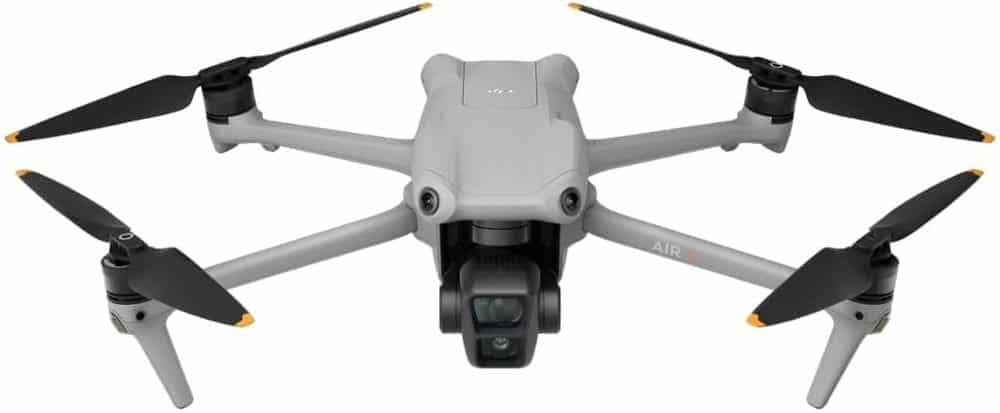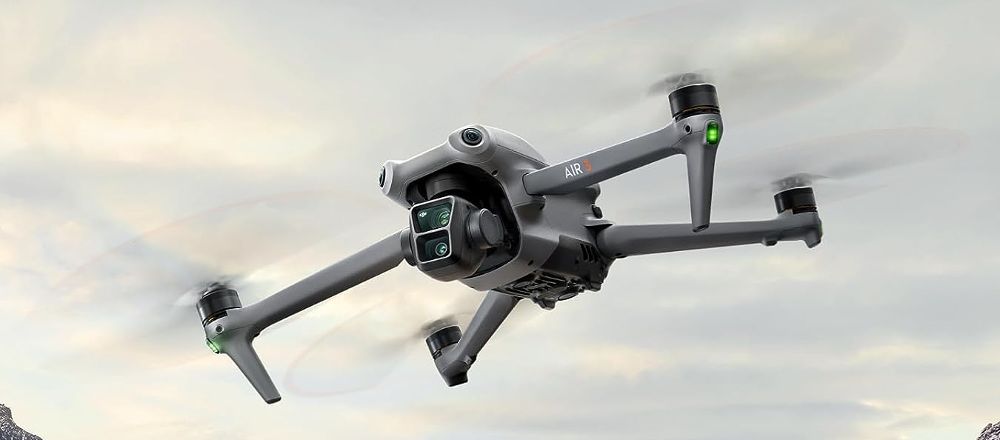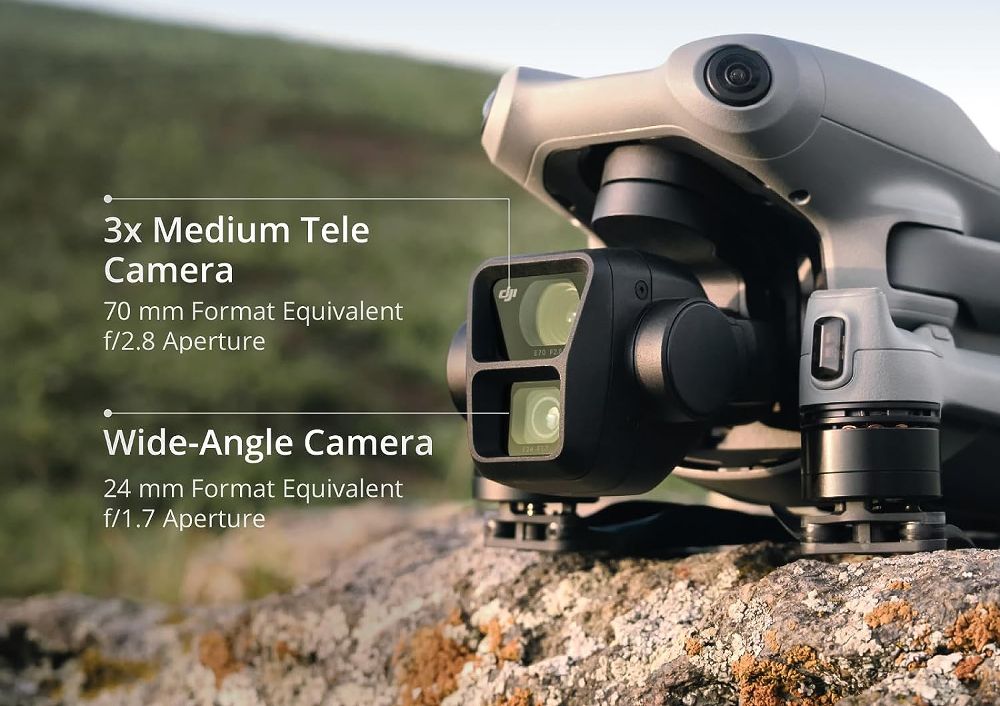DJI Air 3 Review Summary
 The DJI Air 3, with its dual camera system, AI capabilities, and competitive pricing, raises the expectations for consumer drones. It’s a versatile drone that is designed to cater to both professional and hobbyist drone users.
The DJI Air 3, with its dual camera system, AI capabilities, and competitive pricing, raises the expectations for consumer drones. It’s a versatile drone that is designed to cater to both professional and hobbyist drone users.
One of the primary features of the DJI Air 3 is its dual-camera system. This system includes a 24mm F1.7 wide-angle camera and a 70mm F2.8 medium tele camera. Both cameras are capable of shooting 48MP photos and recording 4K videos at 60fps, and they support 10-bit D-Log M colour mode. This means that the drone can capture high-quality, professional-grade photos and videos in a variety of environments and lighting conditions.
Another major update to this drone is its omnidirectional obstacle avoidance system, which uses binocular vision technology to sense and avoid obstacles in all directions.
This not only enhances the safety of the flight but also ensures smoother footage, making it a great choice for those looking to capture professional-grade aerial footage.
The drone impresses with its long battery life, which provides it with a flight time of 46 minutes, making it one of the best drones with the longest flight times.
In conclusion, the DJI Air 3 is a high-quality, advanced drone that offers a range of features designed for professional photography. Whether you’re a professional videographer or a drone enthusiast, the DJI Air 3 is a drone that’s worth considering.
Key Features
- Dual Cameras: The DJI Air 3 is equipped with a dual-primary camera system comprising a wide-angle lens and a 3x medium telephoto lens. This combination ensures consistent image quality and a versatile range of photographic options.
- High-Resolution Imagery: Both cameras on the DJI Air 3 are capable of capturing high-resolution 48MP photos and 4K videos at 60fps with high dynamic range (HDR), delivering breathtaking aerial visuals.
- Extended Flight Duration: With a flight time of up to 46 minutes, the DJI Air 3 provides ample time for pilots to explore their surroundings and compose the perfect shot during a single flight.
- 360-Degree Obstacle Detection: The DJI Air 3 incorporates omnidirectional obstacle sensing technology, using fisheye lenses and 3D TOF sensors to identify and evade obstacles from all directions.
- Advanced Video Transmission: The drone features the cutting-edge O4 video transmission system, offering a transmission range of up to 20 km and enhanced stability for a safer flying experience.
- Smart Tracking and Shooting Modes: The DJI Air 3 includes FocusTrack, which encompasses Spotlight 2.0, ActiveTrack 5.0, and Point of Interest 3.0. These features allow users to maintain their subject at the centre of the frame during flight.
- Vertical Video Capture: The DJI Air 3 supports 2.7K vertical video capture in a 9:16 aspect ratio, facilitating easy sharing of footage on social media platforms without the need for post-cropping.
- Intelligent Imaging: In single-shot mode, the drone’s SmartPhoto 3.0 feature automatically selects the optimal settings (HDR, hyperlight, or scene recognition) to enhance the quality of the captured images.
- Dual camera system capable of recording 4K HDR videos and 48MP photos
- Omnidirectional obstacle avoidance system
- Intelligent video recording modes
- The drone comes with one of the longest flight times for a consumer drone
- Uses the latest DJI video transmission technology for a range of 20km
- The wide camera sensor is not as big as the DJI Air 2S
Two years after the release of the DJI Air 2S, the long-awaited DJI Air 3 has finally arrived. This latest entrant in DJI’s consumer drone lineup is stirring up considerable excitement among drone enthusiasts. The DJI Air 3 is a perfect fusion of features designed for both hobbyists and professional users, boasting a dual-camera array, 360° obstacle avoidance, and an impressive battery life of 46 minutes. It’s clear that the DJI Air 3 has not only met but exceeded the high expectations set by its popular predecessor. In this DJI Air 3 review, we shall explore all its main features in detail that will allow you to make an informed decision on whether to purchase this drone.
DJI Air 3 Review – Design

The DJI Air 3 showcases a design evolution that sets it apart from its predecessor, the Air 2S, and aligns it more closely with the Mavic 3 and Mavic 3 Pro. Despite its new design and innovative features, the drone maintains the lightweight construction that the DJI Air series is renowned for, striking a balance between portability and functionality.
A standout feature of the DJI Air 3 is its dual camera system, a characteristic it shares with the Mavic 3. This feature elevates the DJI Air 3, setting a new benchmark in the consumer drone market.
The drone is equipped with two pairs of obstacle detection sensors located on the front and back, enhancing its navigational capabilities. It also features several vision sensors on the bottom, an infrared sensor, and a landing light, further augmenting its functionality and safety.
The design also incorporates antennas into the front landing legs, which optimises signal reception and transmission.
Overall, I like the new design, its sleek and has a futuristic look and while it comes with a lot more features, the drone is light weighing less than 800 grams.
The DJI RC 2 controller, which succeeds the DJI RC, brings enhanced functionality while preserving a similar design aesthetic, distinguished by folding antennas on top and a darker grey colour.
The controller is powered by a robust processor, ensuring smooth operation and an intuitive flight control experience.
It incorporates the cutting-edge DJI O4 video transmission technology, supporting a range of frequency bands to bolster anti-interference capabilities and facilitate crystal-clear, low-latency video transmission up to a distance of 20km.
In line with its predecessor, the RC2 has a 5.5-inch built-in FHD display and comes with the pre-installed DJI Fly App. However, a potential drawback for some users is the inability to download third-party apps, which are often essential tools for professional drone pilots.
As an alternative, DJI offers the option to purchase the drone with the basic DJI RC-N2 controller. This lacks an LCD screen, requiring users to attach their smartphones to the controller. This option might be more appealing to many users as it allows for the download of other third-party apps, providing more functionality to the drone.
DJI Air 3 Review – Camera Features

This is where the DJI Air 3 really shines, the camera on the Air 3 is superior to the Air 2S, even though, the primary wide camera comes with a smaller sensor.
This drone is the first in the Air series to feature a dual-primary camera system, housing a 1/1.3-inch CMOS wide-angle camera and a 1/1.3-inch CMOS 3x medium tele camera within its compact body.
The wide-angle camera, with its 1/1.3-inch sensor, 2.4μm pixel size and wide FOV, is perfect for capturing broad, expansive shots.
On the other hand, the medium tele camera, while also having a 2.4μm pixel size, offers a longer focal length of 70mm and an f/2.8 aperture, making it ideal for highlighting details from a distance.
The two cameras share the same sensor size, ensuring consistent image quality across different focal lengths. They can capture 48MP photos, providing true-to-life details and ample room for post-production edits. The dual native ISO support allows for the direct output of 4K/60fps HDR videos without cropping, resulting in highly detailed video footage with rich colouring and natural lighting transitions.
The DJI Air 3 also supports 10-bit D-Log M and 10-bit HLG colour modes in both cameras. The 10-bit D-Log M mode retains more highlight and shadow details, providing increased flexibility during editing, while the 10-bit HLG mode offers a higher dynamic range for excellent imaging results without colour grading.
The drone also supports 2.7K vertical shooting with both cameras, providing a dynamic look when capturing landscapes or subjects. This feature is optimised for social media sharing without the need for post-production editing.
In summary, the DJI Air 3’s camera capabilities offer a wide range of creative possibilities for drone photographers. The combination of a wide-angle and medium tele camera allows for versatile composition options, making it an ideal tool for drone enthusiasts looking to capture visually engaging and professional-quality content.
Intelligent Features
Like all other high-end DJI drones, the DJI Air 3 is equipped with several intelligent features that greatly enhance the drone photography capability. These include:
ActiveTrack 5.0: An advanced subject-tracking feature that allows the drone to autonomously follow and focus on a subject, facilitating the capture of dynamic and engaging footage without manual piloting.
Spotlight 2.0: A feature designed for tracking fast-moving or continuously moving subjects, keeping them in the centre of the frame throughout the flight to ensure they remain the main focus of the shot.
Point of Interest: A feature that allows users to set a specific point as the centre of focus. The drone then orbits around that point, capturing captivating and cinematic footage from various angles.
QuickShots: Pre-programmed flight manoeuvres that add creativity to aerial videography. Options like Rocket, Dronie, Circle, Helix, Boomerang, and Asteroid allow users to capture impressive aerial shots effortlessly without advanced piloting skills.
MasterShots: An evolution of the Quickshot feature that enables the Air 3 to automatically perform diverse camera movements and capture multiple clips. These clips are then edited together with music, cuts, and effects to create fast and simplified cinematic footage.
The Air 3 also offers various creative shooting modes, such as Hyperlapse, Slow Motion, and SmartPhoto 3.0, to add unique perspectives to your videos and images.
The SmartPhoto 3.0 feature is an intelligent mode that automatically selects the optimal settings and shooting parameters based on the scene, ensuring that users capture the best possible photos and videos with ease.
The Waypoint Flight feature is a new addition to the Air series. Users can plan flight routes and shooting actions in advance, allowing for complex camera movements and stunning one-takes. This feature is helpful for pilots who may want to use their drones for mapping and 3D modelling.
These intelligent features in the DJI Air 3 enhance the drone’s functionality and make it an excellent tool for drone photographers looking to capture unique and visually stunning aerial content with ease and creativity.
DJI Air 3 Obstacle Avoidance System
The DJI Air 3 drone is equipped with an advanced obstacle avoidance system, which includes 2 pairs of sensors on the front and back. This system provides 360° environmental awareness, allowing the drone to detect and avoid obstacles in all directions. This system is a clear upgrade to the Air 2S, which only provides 4-way obstacle avoidance.
So, how does the obstacle avoidance system perform?
The video below offers a compelling demonstration of the DJI Air 3’s obstacle-avoidance capabilities. As you’ll observe, the drone performs admirably under challenging conditions. The telephoto lens is employed to enhance tracking capabilities, aiding the drone as it skillfully navigates through trees and obstacles while positioned behind the pilot. The drone is also tested from the front, where it faces more challenging conditions. Despite encountering some difficulties, the drone effectively avoids crashing, showcasing its robust obstacle-avoidance capabilities. The DJI Air 3’s impressive performance in these demanding situations is a testament to its advanced design and technology.
DJI Air 3 Price
The DJI Air 3 Drone is available in several packages, each with its own price point and set of included features. The base DJI Air 3 package, which includes the DJI RC-N2, is priced at $1,099. For those seeking additional features, the DJI Air 3 Fly More Combo, also with the DJI RC-N2, is available at a retail price of $1,349. The most comprehensive package, the DJI Air 3 Fly More Combo with the DJI RC 2, is priced at $1,549. The Fly More Combos offer added value with the inclusion of two extra batteries, a shoulder bag, and a DJI charging hub.
Final Thoughts
The DJI Air 3 is a remarkable drone that combines advanced features with user-friendly operation. Its robust design, impressive dual camera system, and sophisticated obstacle avoidance capabilities make it a standout in the drone market.
Whether you’re a professional aerial photographer, a videographer, or a drone enthusiast, the DJI Air 3 is designed to meet your needs. Its advanced features and ease of use make it an excellent choice for both beginners and experienced pilots.
FAQs
Do you have to register the DJI Air 3?
Yes, you will need to register the drone with the FAA; if you are going to be using it to make money or for any other commercial purposes, you will also need to obtain the Part 107 certificate.
Is the DJI Air 3 waterproof?
No, the DJIR Air 3 is not waterproof; this is true for all consumer drones from DJI, the drone may have some resistance to light rain but generally, it is advised by DJI not to operate the DJI Air 3 in wet weather.
Does The DJI Air 3 have remote ID?
Yes, all new DJI drones come with remote ID technology, including the DJI Air 3.
Is The DJI Air 3 Suitable For Beginners?
Yes, the DJI Air 3 is suitable for beginners due to its user-friendly features. However, given its high cost and professional-grade capabilities, it might be more economical for beginners to start with a less expensive drone to learn the basics before investing in a high-end model like the DJI Air 3.

